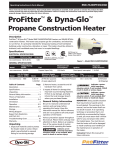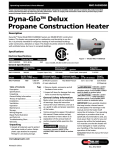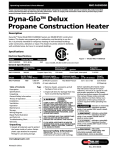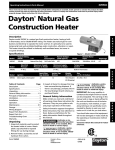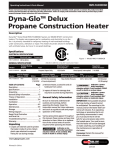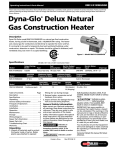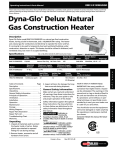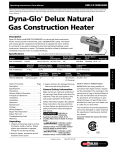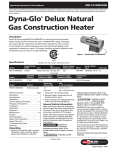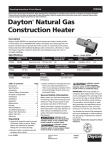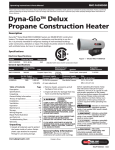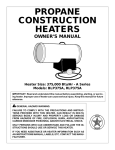Download Dayton 3VE59C Operating instructions
Transcript
3VE59C Operating Instructions & Parts Manual Please read and save these instructions. Read carefully before attempting to assemble, install, operate or maintain the product described. Protect yourself and others by observing all safety information. Failure to comply with instructions could result in personal injury and/or property damage! Retain instructions for future reference. Dayton Propane Construction Heater ® Description E N G L I S H Dayton Model 3VE59C heaters are 300,000 BTU/Hr construction heaters. This heater uses propane gas for combustion, and electricity to run the fan. It is primarily intended for temporary heating of well-ventilated buildings under construction, alteration or repair. This heater should be utilized in sheltered, well-ventilated areas, but never in occupied dwellings. Specifications GHP Group, Inc. 8280 Austin Avenue Morton Grove, IL 60053 ELECTRICAL SPECIFICATIONS Model Electrical InputAmperage 3VE59C 120 V, 60 Hz 0.65 C General SPECIFICATIONS C Figure 1 – Model 3VE59C US US CSA 2.14b-2009, ANS Z83.7b-2009 Construction Heater Model Output Rating BTU/Hr Fuel 3VE59C 300,000 Propane Vapor Only Maximum FuelRegulator Consumption Ignition Outlet Pressure 13.9 Lbs/Hr Direct spark, interrupted 7-10 PSIG Hot Air Output ModelApprox. (CFM) Motor Minimum Supply Pressure to Regulator 3VE59C 1800 25 PSIG (for purposes Max. Bottle Pressure 33.7 x 12.6 x 18.5 of input adjustment) 0.085 HP 1,720 RPM Table of Contents Page Description . . . . . . . . . . . . . . . . . . . . . . . 1 Specifications . . . . . . . . . . . . . . . . . . . . . 1 Unpacking . . . . . . . . . . . . . . . . . . . . . . . 1 General Safety Information . . . . . . . . 1-3 Theory of Operation . . . . . . . . . . . . . . . 3 Installation . . . . . . . . . . . . . . . . . . . . . . 3-4 Ventilation . . . . . . . . . . . . . . . . . . . . . . . 4 Operation . . . . . . . . . . . . . . . . . . . . . . . 4-5 Maintenance . . . . . . . . . . . . . . . . . . . . 5-6 Storage . . . . . . . . . . . . . . . . . . . . . . . . . . 6 Wiring Diagram . . . . . . . . . . . . . . . . . . . 6 Repair Parts Illustration and Parts List . . . . . . . . . . . . . . . . . . . 8-9 Troubleshooting Chart . . . . . . . . . . . . 10 Warranty . . . . . . . . . . . . . . . . . . . . . . . . 10 Unpacking 1.Unpack all materials used to protect the heater inside of carton. Retain plastic caps attached to exposed fitting for use during storage. Form 5S6059 Maximum Supply Size Pressure to RegulatorL x W x H (Inches) 2.Remove heater, accessories and all hardware from carton. 3.Inspect all items for damage that may have occurred during shipment. General Safety Information Be sure to read and understand all cautions and warnings, before operating this heater. Keep this instruction manual for future reference, and use it as a guide to safe and proper operation of the heater. Various precautions appear throughout this manual. Please review and pay close attention to them. Below is an explana tion of the various levels of caution required while operating this heater. Indicates an imminen tly hazardous situation which, if not avoided, WILL result in death or serious injury. Printed in China 09663 0510/222/VCPVP Weight (pounds) 33.9 (Heater) 42 (Shipping) Indicates a potentially hazardous situation which, if not avoided, COULD result in death or serious injury. Indicates a potentially hazardous situation which, if not avoided, MAY result in minor or moderate injury. IMPORTANT: Every possible situation that may involve a hazard cannot be anticipated. The warnings in this manual, and on the heater itself cannot be all inclusive. If an operating technique or procedure that is not specifically recommended by Dayton is used, you must assure that it will be safe for you and anyone else within the heated space. You must be sure that the heater will not be damaged or made unsafe by your handling of the maintenance or operation of the heater. F R A N Ç A I S Consumer: Retain this manual for future reference. GGS #119 2012-05-31 E S P A — O L ® 3VE59C Dayton Operating Instructions and Parts Manual Dayton Propane Construction Heater ® E N G L I S H General Safety Information (Continued) General Hazard Warning: Failure to comply with the precautions and instructions provided with this heater can result in death, serious bodily injury, and property loss, or damage from hazards of fire, explosion, burn, asphyxiation, carbon monoxide poisoning, and/or electrical shock. Only persons who can understand and follow these instructions should use or service this heater. If you need assistance or heater information such as an instruction manual, labels, etc. contact your local Grainger branch. Fire, burn, inhalation, and explosion hazard: Keep solid combustibles such as building materials, paper, or cardboard, at a safe distance away from heater as recommended by the instructions. Never use the heater in spaces which do or may contain volatile or airborne combustibles or products such as gasoline, solvents, paint thinner, dust particles, or unknown chemicals. Not for home or recreational vehicle in specific applications. Your local authority can advise you about these. - Do not use the heater in occupied dwellings. - Do not use heater in living or sleeping quarters. -For either indoor or outdoor use. Adequate ventilation must be provided. Carbon Monoxide Poisoning: Some people are more affected by carbon monoxide than others. Early signs of carbon monoxide poisoning resemble the flu, with headaches, dizziness, and/ or nausea. If you have these signs, the heater may not be operating properly. Get fresh air at once! Have heater serviced. Propane Gas: Propane gas is odorless. An odor-making agent is added to propane gas. The odor helps you detect a propane gas leak. However, the odor added to propane gas can fade. Propane gas may be present even though no odor exists. California Proposition 65 Warning: Fuels used in gas or oil fired appliances and the products of combustion of such fuels, contain chemicals known to the State of California to cause cancer, birth defects or other reproductive harm. This product contains chemicals, including lead and lead compounds, known to the state of California to cause cancer, birth defects or other reproductive harm. Wash hands after handling. Carefully install and always use great care when operating this heater. Be sure to research and follow all local ordinances and codes. In the absence of local codes, with the Standard for the Storage and Handling of Liquefied Petroleum Gases, ANSI/NFPA 58 and the Natural Gas and Propane Installation Code CSA B149.1. The heater is designed and approved for use as a construction heater in accordance with Standard CSA 2.14b2009, ANS Z83.7b-2009. - The heater is designed and approved for use as a construction heater in accordance with CSA 2.14b-2009, ANS Z83.7b-2009. Check with your local fire safety authority if you have questions about applications. - Other standards govern the use of fuel gases and heat producing products - Use only in well-vented areas. Before using heater, provide at least a threesquare-foot opening of fresh, outside air for each 100,000 BTU/Hr of rating. - Keep appliance area clear and free from combustible materials, gasoline, paint thinner, and other flammable vapors and liquids. Do not use heater in areas with high dust content. use. For Technical Support or Troubleshooting, Call: 1-800-323-0620 2 - Keep heater away from strong drafts, water spray, rain, or dripping water. - Install and use heater with care. Follow all local ordinances and codes. In the absence of local ordinances and codes, refer to ANSI/NFPA 58. This instructs on the safe storage and handling of propane gases. - Check heater for damage before each use. Do not use a damaged heater. - Use only propane gas set up for vapor withdrawal. - The electrical connections and grounding of the heater shall follow the National Electric Code, ANSI/NFPA 70. - Keep propane tank(s) below 100°F. - Do not use heater below ground level. Propane gas is heavier than air. If a leak occurs, propane gas will sink to the lowest possible level. - Use only the electrical voltage and frequency specified on model plate. - Electrical grounding instructions This appliance is equipped with a three-prong (grounding) plug for your protection against shock hazard and should be plugged directly into a properly grounded three-prong receptacle. - Use only a three-prong, grounded extension cord. - Use only the hose and factory regulator provided with the heater. - Inspect hose before each use of heater. If highly worn or cut, replace before using heater. Use the replacement hose assembly specified in this manual. - The heater, other than a heater with integral propane gas container, must be located at least 6 feet (in Canada, distance must be 10 feet) from any propane gas container. Do not point heater at propane tank(s) within 20 feet. Dayton Operating Instructions and Parts Manual Model 3VE59C General Safety Information (Continued) Minimum heater clearances from combustibles: Outlet: 8 Ft. Sides: 2 Ft. Top: 6 Ft.Rear: 2 Ft. - Locate heater on stable and level surface if heater is hot or running. - Keep children and animals away from heater. - Turn off propane supply and unplug heater when not in use. - When used with optional thermostat, heater may start anytime. - Never block air inlet (rear) or air outlet (front) of heater. - Use only original replacement parts. This heater must use design-specific parts. Do not substitute or use generic parts. Improper replacement parts could cause serious or fatal injuries. SAFETY CONTROL SYSTEM - Do not adjust regulator below 7 PSIG or above 10 PSIG. Propane Supply Theory of Operation FUEL SYSTEM The hose/regulator assembly runs from the propane supply to the heater itself. After the gas runs through the hose and regulator, it passes through the solenoid valve and out the nozzle into the combustion chamber. AIR SYSTEM - Do not alter heater. Keep heater in its original state. The internal motor turns the fan, which pushes air around and through the combustion chamber. Here the air is heated and provides a constant stream of warmth. - Do not use heater if altered. IGNITION SYSTEM - Never attach ductwork to front or rear of heater. The spark module sends voltage to the ignitor. The ignitor ignites the fuel and air mixture. - Never move, handle, or service a hot, operating, or plugged-in heater. Ignitor Motor Fan Clean Heated Air Out (Front) Cool Air In (Back) On/Off Switch Power Cord Combustion Chamber Air For Heating Nozzle Solenoid Valve Hose / Regulator PCB Control Assembly Spark Module (Spark Ignitor) Air For Combustion E N G L I S H This system shuts the heater down if the flame is extinguished. The fan and motor will continue to operate, but there will not be any heat. All propane gas and tanks are to be provided by the user. This heater should only be used with a tank that has a vapor withdrawal system. Refer to the Standard of Storage and Handling of Liquefied Petroleum Gas, ANSI/NFPA 58, Chapter 5. Your local fire department or library will have this information. Two factors will dictate how much propane is used from each tank: 1.The amount of gas in each tank. 2.The surrounding air temperature at each tank. The chart below shows how many tanks should be used at a given temperature. This heater should not be operated with a tank smaller than 100 pounds. Average Temperature (°F) at Tank Location 40 32 20 10 0 -10 -20 Number of Tanks 3 Use larger tank Use larger tank Use larger tank Use larger tank Use larger tank Use larger tank As the temperature drops, less gas is vaporized, so a larger tank may be necessary in very cold weather. Never operate this heater with a tank smaller than 100 pounds. Your local propane dealer can help you select the proper tank size and configuration. Figure 2 – Cross Section Operational View For Technical Support or Troubleshooting, Call: 1-800-323-0620 3 ® 3VE59C Dayton Operating Instructions and Parts Manual Dayton Propane Construction Heater ® E N G L I S H Installation Operation Review and under stand all of the warnings in the Safety Information Section on pages 1–3. They are required to operate this heater safely. Follow all local and state codes when operating this heater. After installing all gas piping, and making the proper connections, be sure to check for leaks. Apply a 50/50 mixture of dish soap and water to all connections. Bubbles forming are evidence of a leak. Be sure to correct all leaks at once! Review and under stand all of the warnings in the Safety Information Section, on pages 1–3. They are required to operate this heater safely. Follow all local and state codes when operating this heater. 1.Provide propane supply system as outlined above. 2.Connect POL fitting on hose/regulator assembly to propane tank(s) by turn ing the fitting COUNTERCLOCKWISE into the threads on the valve on top of the tank. Finish by tightening firmly, using 7/8” wrench. IMPORTANT: To protect the regulator from weather damage, tighten the fitting with the black adjustment knob pointing down. POL Fitting Supply Valve Propane/LP Tank Hose Hose TO START HEATER Inlet Connector supplied with the heater. Figure 4 – Hose and Inlet Connector 4.Open supply valve on propane tank(s) SLOWLY. NOTE: If this valve is not opened slowly, the excess flow check valve on the tank will interrupt the gas flow. If this happens, close the supply valve and reopen slowly. 5.Adjust the regulator to between 7 and 10 PSIG. Do not adjust the regulator above 10 PSIG or below 7 PSIG, or the heater may not operate properly. 6.Check all connections for leaks. Never use an open flame to check for leaks. Apply a 50/50 solution of liquid dish soap and water to check all connections. Correct all leaks immediately. 7.Close propane supply valve. Ventilation Regulator Adjustment Knob (Pointing Down) Figure 3 – Regulator with Vent Pointing 3.ConnectDown female end of hose to the inlet connector of the heater, and tighten firmly with a wrench. IMPORTANT: Use extra piping or hose if necessary to connect the heater to the gas supply, but always use the regulator Always follow the minimum fresh air ventilation requirements. If these guidelines are not followed, carbon monoxide poisoning can occur. Always provide proper amounts of fresh air before operating this heater. Provide at least three square feet of fresh, outside air for each 100,000 BTU/ Hr of rating. This heater requires a fresh air opening of at least 11.25 square feet. Provide extra fresh air if more heaters are being used. For Technical Support or Troubleshooting, Call: 1-800-323-0620 4 1.Follow all safety, installation and ventilation instructions in this manual. 2.Position the heater on a stable and level surface, and be sure that no drafts blow into the inlet or outlet of the heater. 3.Plug the power cord of the heater into a three hole grounded extension cord. Be sure that the extension cord is at least 6 feet long, and is UL listed. EXTENSION CORD SIZE REQUIREMENT • Up to 50 feet long, use 18 AWG rated cord. • 51 to 100 feet long, use 16 AWG rated cord. • 101 to 200 feet long, use 14 AWG rated cord. 4.Plug extension cord into a 120 volt/60 hertz, three hole grounded outlet. 5.Open supply valve on propane tank(s) SLOWLY. NOTE: If this valve is not opened slowly, the excess flow check valve on the tank will interrupt the gas flow. If this happens, close the supply valve and reopen slowly. 6.Adjust the regulator to between 7 and 10 PSIG. NOTE: The higher regulator setting will enable the heater to produce more heat. Dayton Operating Instructions and Parts Manual Model 3VE59C Operation (Continued) Maintenance FAN Do not adjust the regulator above 10 PSIG or below 7 PSIG, or the heater may not operate properly. Do not attempt to service the heater while it is hot, operating or plugged in. Severe burns or electrical shock can occur. IMPORTANT: Always remove the fan from the motor shaft before removing the motor assembly from the heater. This will help prevent damage to the fan. 7.Turn on/off switch to the “ON” (I) position. Heater will start within twenty seconds. NOTE: If the heater does not start following this procedure, turn on/off switch to “OFF” (O) position and wait 5 minutes. This will allow the safety control to reset, and you can try to light the heater once again. TO SHUT DOWN HEATER 1.Tightly close control valve on propane tank(s). 2.Give the heater a few seconds to burn the gas still left in the hose. 3.Turn on/off switch to the “OFF” (O) position. 4.Unplug extension cord from power source. TO RESTART HEATER NOTE: If the safety control stops the flow of gas to the heater, the motor will continue to run. To restart the heater: 1.Be sure to inspect the heater before each use. Check for leaks using the method described on Page 4. Repair any leaks immediately. 2.Always keep heater clean. Clean the heater annually, or as often as needed to remove any dust or debris. When the heater becomes dirty, wipe it down with a damp cloth. 3.Keep the inside of the heater free from foreign objects and combustibles. 2.Remove fan guard. 3.Remove base. 4.Disconnect lead wires attached to the motor. 5.Remove motor assembly. 6.Remove fan setscrew using a 1/8” Allen wrench (see Figure 6). Setscrew 5.Keep inside of heater free of foreign objects and combustible materials. Fan SERVICE PROCEDURES Never service heater while hot, operating or connected to the gas supply. Severe burns or electrical shock may occur. REMOVING PROTECTIVE COVER 1.Remove base lower at the bottom of the heater. 2.Wait five minutes, then turn switch to the “ON” (I) position. 2.Remove fan guard. Motor Shaft Figure 6 – Fan Motor Shaft and Setscrew Location 7.Using a soft cloth moistened with kerosene or a cleaning solvent, carefully clean the fan blades making sure not to bend them. 8.Dry fan with clean cloth. If heater does not restart: Fan Guard • Check all control valves to assure that they are open. If heater still does not restart, contact your nearest Service Center. 1.Remove base lower. 4.Have the heater inspected annually by a qualified service person. 1.Turn on/off switch to the “OFF” (O) position. • Check the fuel level in the propane tanks. If the level is too low, replace the tank with a full one. E N G L I S H 9.Making sure that the setscrew lines up with the flat spot on the motor shaft, replace fan as shown in Figure 7. Tighten setscrew firmly (be careful not to overtighten). Base Base Lower Figure 5 – Protective Cover Removal For Technical Support or Troubleshooting, Call: 1-800-323-0620 5 ® 3VE59C Dayton Operating Instructions and Parts Manual Dayton Propane Construction Heater ® Maintenance (Continued) IGNITOR The only maintenance necessary for the ignitor is to be sure that the gap between the electrodes is kept between .10” and .15”. The ignitor is accessible through the combustion chamber. Fan Setscrew Storage Motor Shaft Always disconnect the heater from the propane tanks when not in use. Hub 1.Always store propane tanks in accor dance with Chapter 5 of the Standard for storage and handling of Liquefied Petroleum Gasses, ANSI/NFPA 58. Follow all local codes. Figure 7 – Fan Cross Section 10.Reconnect lead wires as shown in the Wiring Diagram (Figure 8). 11.Reassemble base, fan guard and base lower. 2.Replace the plastic caps over the fittings that were installed when you originally unpacked your heater. 3.Store the heater in a safe, clean and dry location. Do not store the hose/regulator assembly inside the combustion chamber of the heater. 4.When removing the heater from storage, always check inside of the heater for any foreign objects left by spiders or small animals. Keep the inside of the heater clean from foreign objects and combustibles. Wiring Diagram High Limit Switch Yellow Solenoid Valve White Chassis Ground White Back Pressure Switch Spark Plug Black Blue Condenser Orange White Black Motor White Black Line Seat White Yellow on / off Black Green White Thermostat Red E N G L I S H Chassis Ground Line Neut Valve Ground Flame Control Power Cord Figure 8 – Wiring Diagram Chassis Ground Green If any original wiring as supplied with the heater must be replaced, it must be replaced with type AWG105°C wire or its equivalent except as indicated (∗Type SF2-200, ∗∗SGI-250°C) For Technical Support or Troubleshooting, Call: 1-800-323-0620 6 3VE59C Dayton Operating Instructions and Parts Manual Notes E N G L I S H For Technical Support or Troubleshooting, Call: 1-800-323-0620 7 3VE59C Dayton Operating Instructions and Parts Manual For Repair Parts, call 1-800-323-0620 24 hours a day – 365 days a year Please provide following information: -Model number -Serial number (if any) -Part description and number as shown in parts list E N G L I S H 1 3 5 6 7 8 12 13 14 18 17 15 19 16 26 9 10 4 20 22 11 28 53 56 57 55 27 31 29 32 30 51 54 58 25 21 2 52 50 23 24 33 35 49 42 47 36 38 48 43 46 41 39 40 37 45 Figure 9 – Repair Parts Illustration for Propane Construction Heater For Technical Support or Troubleshooting, Call: 1-800-323-0620 8 34 44 Dayton Operating Instructions and Parts Manual Model 3VE59C Repair Parts List for Propane Construction Heater Ref. Part No. DescriptionNo. Qty. 1 2 3 4 5 6 7 8 9 10 11 12 13 14 15 16 17 18 19 20 21 22 23 24 25 26 27 28 29 30 31 1 6 1 3 2 2 1 2 1 1 3 1 1 1 3 1 1 1 2 2 1 1 1 1 1 3 1 2 1 1 1 Inner Shell Assembly Screw Frame Holder Screw Nut Sleeve Thermal Switch Screw Nut Spark Plug Assembly Bolt Burner Top Inner Ring Burner Nut Burner Tube Assembly Outer Shell Handle Assembly Screw Nut Motor Assembly Fan Assembly Motor Support Motor Bracket Fan Guard Screw Thermostat Assembly Screw Clip Screw Nut 2315586 2001355 2315587 2001355 2000112 2315511 2201153 2001059 2305686 2315582 2001447 2315603 2315602 2315601 2000121 2315600 2315585 2101447 2000416 2000384 2315590 2315592 2315584 2315591 2315500 2001355 2201186 2000375 2301973 2000375 2000231 Ref. Part No. DescriptionNo. Qty. 32 33 34 35 36 37 38 39 40 41 42 43 44 45 46 47 48 49 50 51 52 53 54 55 56 57 58 1 1 1 1 1 2 1 1 1 2 2 1 1 6 1 2 2 1 1 2 4 1 1 1 1 1 1 For Technical Support or Troubleshooting, Call: 1-800-323-0620 9 Capacitor 2201586 Bushing Strain Relief 2101633 Power Cord Assembly 2201163 Switch 2201549 Solenoid Valve 2315449 Screw 2001206 Connector Inlet 2315595 Fitting 2315596 Solenoid Valve Bracket 2315594 Screw 2000416 Nut 2000384 Back Pressure Switch 2201594 Base Lower 2315589 Screw 2001355 Pcb Assembly 2201181 Screw 2001445 Nut 2000231 Base 2315588 Plastic Tube 2101052 Aluminum Tube Bracket 2315700 Screw 2001355 Aluminum Tube 2315699 Tubing Assembly 2315599 Nozzle Base 2315598 Nozzle 2315597 Knob 2101207 Regulator & Hose Assembly2315448 (MH17224) E N G L I S H 3VE59C Dayton Operating Instructions and Parts Manual Dayton Propane Construction Heater ® Troubleshooting Chart E N G L I S H Symptom Possible Cause(s) Fan does not turn when electrical connection is made 1. No electric power to heater Corrective Action 1. Check current to electric outlet. If voltage is correct, check power cord and extension cord for cuts and breaks 2. Fan blade contacts inside of heater 2. Be sure that housing is not damaged. Make sure housing there are no obstructions to the fan 3. Fan blade(s) bent 3. Straighten blade(s) to match others 4. Fan motor defective 4. Replace motor Heater will not fire 1. No spark at igniter 1. Check igniter wire. Reattach or tighten if loose. Check spark module. Replace if necessary. Check all electrical components 2. Improper spark gap 2. Set gap to 0.08” 3. Bad electrode 3. Replace spark plug Heater quits while 1. Internal temperature too high causing 1. If the heaters output is restricted, internal tem running limit switch to shut down operation perature becomes too high. Move heater away from any obstructions 2. Damaged control valve 2. Replace control valve 3. Dust or debris build-up inside of heater 3. Clean inside of heater Always be sure to follow proper maintenance procedures, by cleaning the heater once per month during regular usage, and check spark gap at least once per season. Limited Warranty Dayton One-Year Limited Warranty. DAYTON® PROPANE CONSTRUCTION HEATER, MODELS COVERED IN THIS MANUAL, ARE WARRANTED BY DAYTON ELECTRIC MFG. CO. (DAYTON) TO THE ORIGINAL USER AGAINST DEFECTS IN WORKMANSHIP OR MATERIALS UNDER NORMAL USE FOR ONE YEAR AFTER DATE OF PURCHASE. ANY PART WHICH IS DETERMINED TO BE DEFECTIVE IN MATERIAL OR WORKMANSHIP AND RETURNED TO AN AUTHORIZED SERVICE LOCATION, AS DAYTON DESIGNATES, SHIPPING COSTS PREPAID, WILL BE, AS THE EXCLUSIVE REMEDY, REPAIRED OR REPLACED AT DAYTON’S OPTION. FOR LIMITED WARRANTY CLAIM PROCEDURES, SEE “PROMPT DISPOSITION” BELOW. THIS LIMITED WARRANTY GIVES PURCHASERS SPECIFIC LEGAL RIGHTS WHICH VARY FROM JURISDICTION TO JURISDICTION. Limitation of Liability. TO THE EXTENT ALLOWABLE UNDER APPLICABLE LAW, DAYTON’S LIABILITY FOR CONSEQUENTIAL AND INCIDENTAL DAMAGES IS EXPRESSLY DISCLAIMED. DAYTON’S LIABILITY IN ALL EVENTS IS LIMITED TO AND SHALL NOT EXCEED THE PURCHASE PRICE PAID. Warranty Disclaimer. A DILIGENT EFFORT HAS BEEN MADE TO PROVIDE PRODUCT INFORMATION AND ILLUSTRATE THE PRODUCTS IN THIS LITERATURE ACCURATELY; HOWEVER, SUCH INFORMATION AND ILLUSTRATIONS ARE FOR THE SOLE PURPOSE OF IDENTIFICATION, AND DO NOT EXPRESS OR IMPLY A WARRANTY THAT THE PRODUCTS ARE MERCHANTABLE, OR FIT FOR A PARTICULAR PURPOSE, OR THAT THE PRODUCTS WILL NECESSARILY CONFORM TO THE ILLUSTRATIONS OR DESCRIPTIONS. EXCEPT AS PROVIDED BELOW, NO WARRANTY OR AFFIRMATION OF FACT, EXPRESSED OR IMPLIED, OTHER THAN AS STATED IN THE “LIMITED WARRANTY” ABOVE IS MADE OR AUTHORIZED BY DAYTON. Technical Advice and Recommendations, Disclaimer. Notwithstanding any past practice or dealings or trade custom, sales shall not include the furnishing of technical advice or assistance or system design. Dayton assumes no obligations or liability on account of any unauthorized recommendations, opinions or advice as to the choice, installation or use of products. Product Suitability. Many jurisdictions have codes and regulations governing sales, construction, installation, and/or use of products for certain purposes, which may vary from those in neighboring areas. While attempts are made to assure that Dayton products comply with such codes, Dayton cannot guarantee compliance, and cannot be responsible for how the product is installed or used. Before purchase and use of a product, review the product applications, and all applicable national and local codes and regulations, and be sure that the product, installation, and use will comply with them. Certain aspects of disclaimers are not applicable to consumer products; e.g., (a) some jurisdictions do not allow the exclusion or limitation of incidental or consequential damages, so the above limitation or exclusion may not apply to you; (b) also, some jurisdictions do not allow a limitation on how long an implied warranty lasts, consequently the above limitation may not apply to you; and (c) by law, during the period of this Limited Warranty, any implied warranties of implied merchantability or fitness for a particular purpose applicable to consumer products purchased by consumers, may not be excluded or otherwise disclaimed. Prompt Disposition. A good faith effort will be made for prompt correction or other adjustment with respect to any product which proves to be defective within limited warranty. For any product believed to be defective within limited warranty, first write or call dealer from whom the product was purchased. Dealer will give additional directions. If unable to resolve satisfactorily, write to Dayton at address below, giving dealer’s name, address, date, and number of dealer’s invoice, and describing the nature of the defect. Title and risk of loss pass to buyer on delivery to common carrier. If product was damaged in transit to you, file claim with carrier. Manufactered for W.W. Grainger, Inc. 100 Grainger Parkway, Lake Forest, IL 60045 U.S.A. by GHP Group, Inc., Morton Grove, IL ®










